Research Proposal: Peer Support and Mental Health Outcomes
VerifiedAdded on 2021/04/17
|19
|4997
|37
Report
AI Summary
This research proposal outlines an observational study designed to evaluate the effectiveness of peer support programs on mental health outcomes for individuals diagnosed with mental illnesses. The study employs a case-control design, comparing a treatment group receiving peer support with a control group receiving standard care. The proposal details the study's aim, objectives, background, research plan, and expected outcomes, including the use of standardized scales like the Lehman's Quality of Life Interview and the Brief Psychiatric Rating Scale to assess changes in participants' mental well-being. The intervention involves trained peer supporters who share their experiences to provide support, education, and encouragement to facilitate recovery. The study population includes patients from community mental health centers and hospitals within the district, with detailed participant selection criteria. The proposal also addresses the study's timeline, anticipated outcomes, and the significance of peer support in complementing existing mental health services.

Running head: RESEARCH PROPOSAL
Assignment 3
Name of the Student
Name of the University
Author Note
Assignment 3
Name of the Student
Name of the University
Author Note
Paraphrase This Document
Need a fresh take? Get an instant paraphrase of this document with our AI Paraphraser
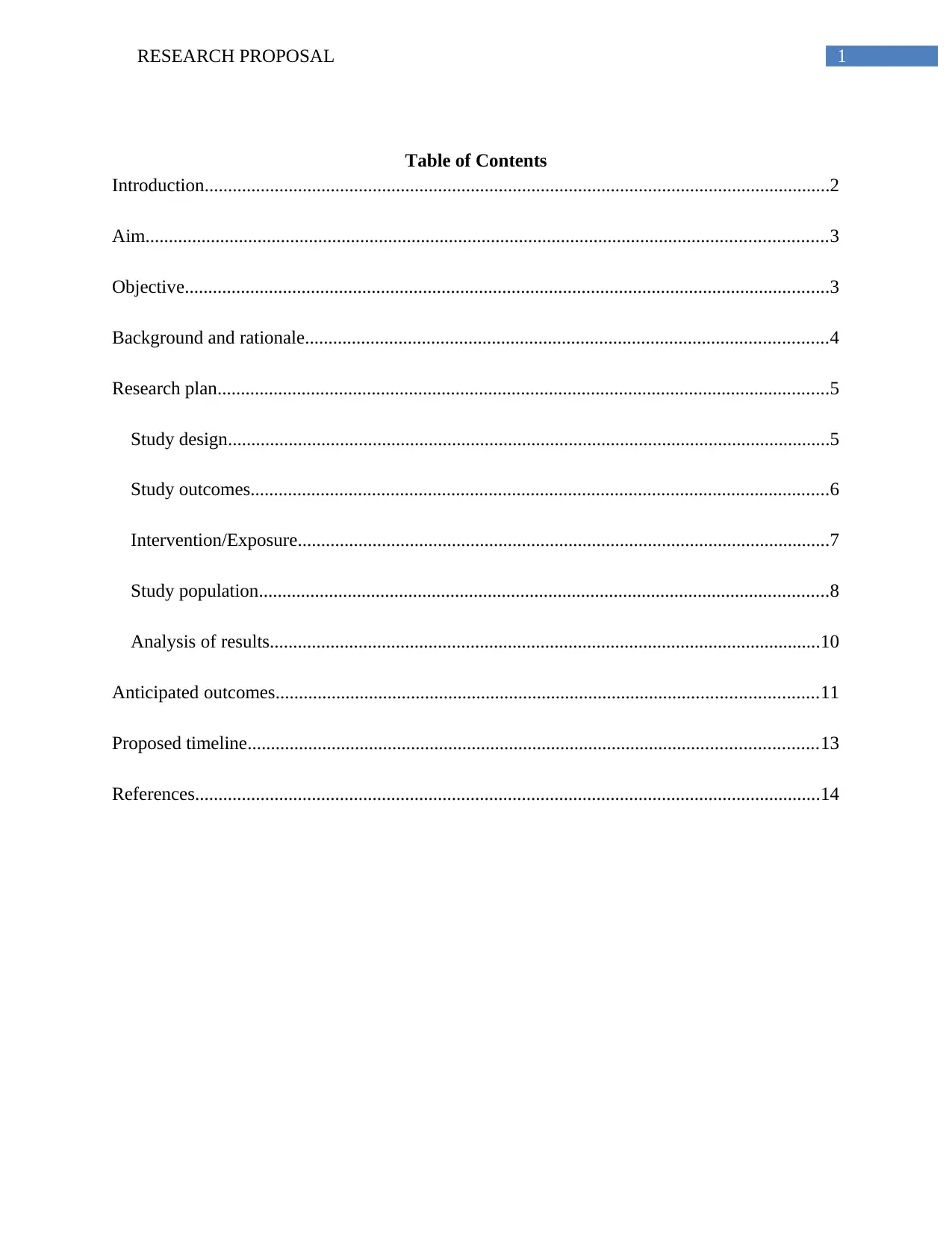
1RESEARCH PROPOSAL
Table of Contents
Introduction......................................................................................................................................2
Aim..................................................................................................................................................3
Objective..........................................................................................................................................3
Background and rationale................................................................................................................4
Research plan...................................................................................................................................5
Study design.................................................................................................................................5
Study outcomes............................................................................................................................6
Intervention/Exposure..................................................................................................................7
Study population..........................................................................................................................8
Analysis of results......................................................................................................................10
Anticipated outcomes....................................................................................................................11
Proposed timeline..........................................................................................................................13
References......................................................................................................................................14
Table of Contents
Introduction......................................................................................................................................2
Aim..................................................................................................................................................3
Objective..........................................................................................................................................3
Background and rationale................................................................................................................4
Research plan...................................................................................................................................5
Study design.................................................................................................................................5
Study outcomes............................................................................................................................6
Intervention/Exposure..................................................................................................................7
Study population..........................................................................................................................8
Analysis of results......................................................................................................................10
Anticipated outcomes....................................................................................................................11
Proposed timeline..........................................................................................................................13
References......................................................................................................................................14
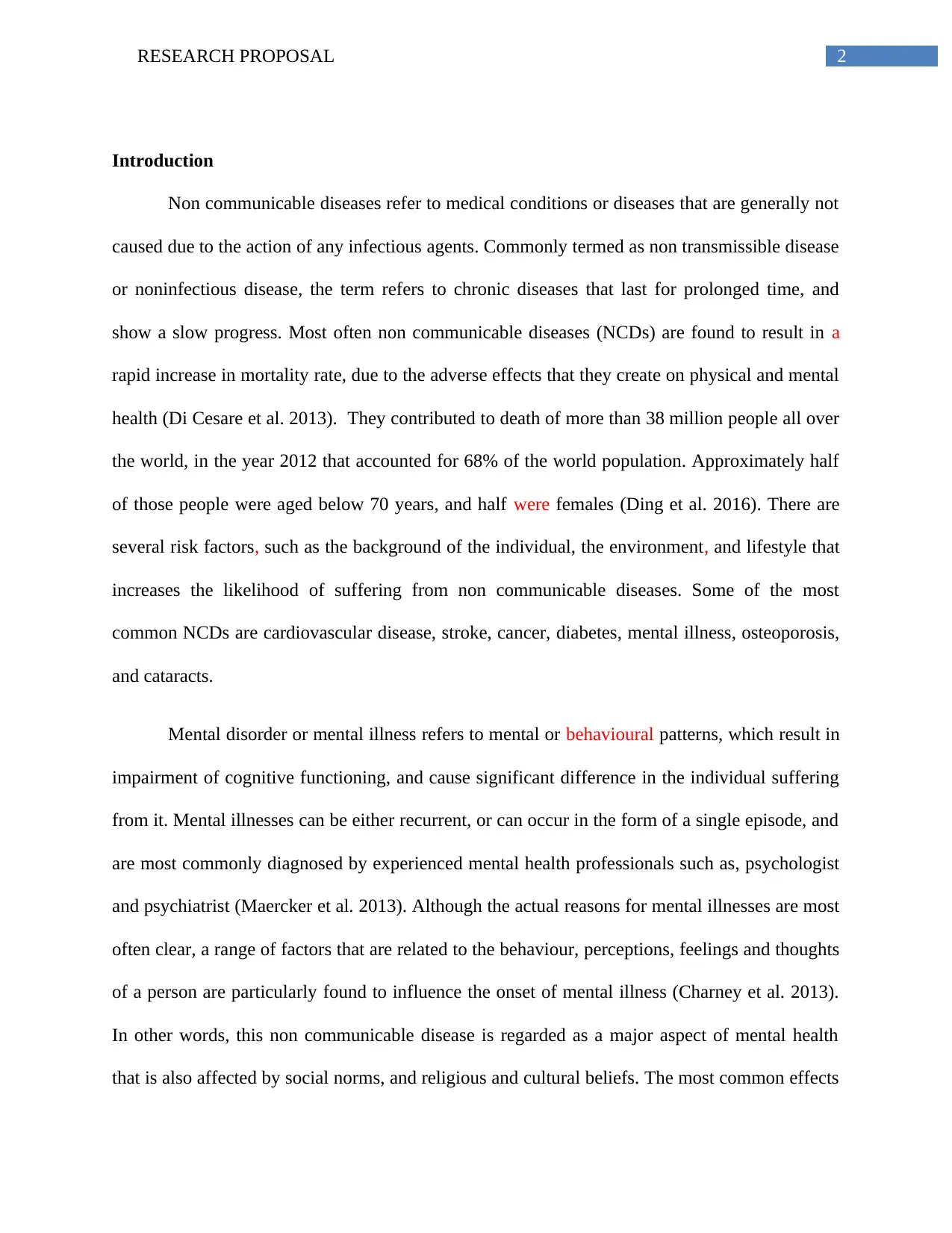
2RESEARCH PROPOSAL
Introduction
Non communicable diseases refer to medical conditions or diseases that are generally not
caused due to the action of any infectious agents. Commonly termed as non transmissible disease
or noninfectious disease, the term refers to chronic diseases that last for prolonged time, and
show a slow progress. Most often non communicable diseases (NCDs) are found to result in a
rapid increase in mortality rate, due to the adverse effects that they create on physical and mental
health (Di Cesare et al. 2013). They contributed to death of more than 38 million people all over
the world, in the year 2012 that accounted for 68% of the world population. Approximately half
of those people were aged below 70 years, and half were females (Ding et al. 2016). There are
several risk factors, such as the background of the individual, the environment, and lifestyle that
increases the likelihood of suffering from non communicable diseases. Some of the most
common NCDs are cardiovascular disease, stroke, cancer, diabetes, mental illness, osteoporosis,
and cataracts.
Mental disorder or mental illness refers to mental or behavioural patterns, which result in
impairment of cognitive functioning, and cause significant difference in the individual suffering
from it. Mental illnesses can be either recurrent, or can occur in the form of a single episode, and
are most commonly diagnosed by experienced mental health professionals such as, psychologist
and psychiatrist (Maercker et al. 2013). Although the actual reasons for mental illnesses are most
often clear, a range of factors that are related to the behaviour, perceptions, feelings and thoughts
of a person are particularly found to influence the onset of mental illness (Charney et al. 2013).
In other words, this non communicable disease is regarded as a major aspect of mental health
that is also affected by social norms, and religious and cultural beliefs. The most common effects
Introduction
Non communicable diseases refer to medical conditions or diseases that are generally not
caused due to the action of any infectious agents. Commonly termed as non transmissible disease
or noninfectious disease, the term refers to chronic diseases that last for prolonged time, and
show a slow progress. Most often non communicable diseases (NCDs) are found to result in a
rapid increase in mortality rate, due to the adverse effects that they create on physical and mental
health (Di Cesare et al. 2013). They contributed to death of more than 38 million people all over
the world, in the year 2012 that accounted for 68% of the world population. Approximately half
of those people were aged below 70 years, and half were females (Ding et al. 2016). There are
several risk factors, such as the background of the individual, the environment, and lifestyle that
increases the likelihood of suffering from non communicable diseases. Some of the most
common NCDs are cardiovascular disease, stroke, cancer, diabetes, mental illness, osteoporosis,
and cataracts.
Mental disorder or mental illness refers to mental or behavioural patterns, which result in
impairment of cognitive functioning, and cause significant difference in the individual suffering
from it. Mental illnesses can be either recurrent, or can occur in the form of a single episode, and
are most commonly diagnosed by experienced mental health professionals such as, psychologist
and psychiatrist (Maercker et al. 2013). Although the actual reasons for mental illnesses are most
often clear, a range of factors that are related to the behaviour, perceptions, feelings and thoughts
of a person are particularly found to influence the onset of mental illness (Charney et al. 2013).
In other words, this non communicable disease is regarded as a major aspect of mental health
that is also affected by social norms, and religious and cultural beliefs. The most common effects
⊘ This is a preview!⊘
Do you want full access?
Subscribe today to unlock all pages.

Trusted by 1+ million students worldwide
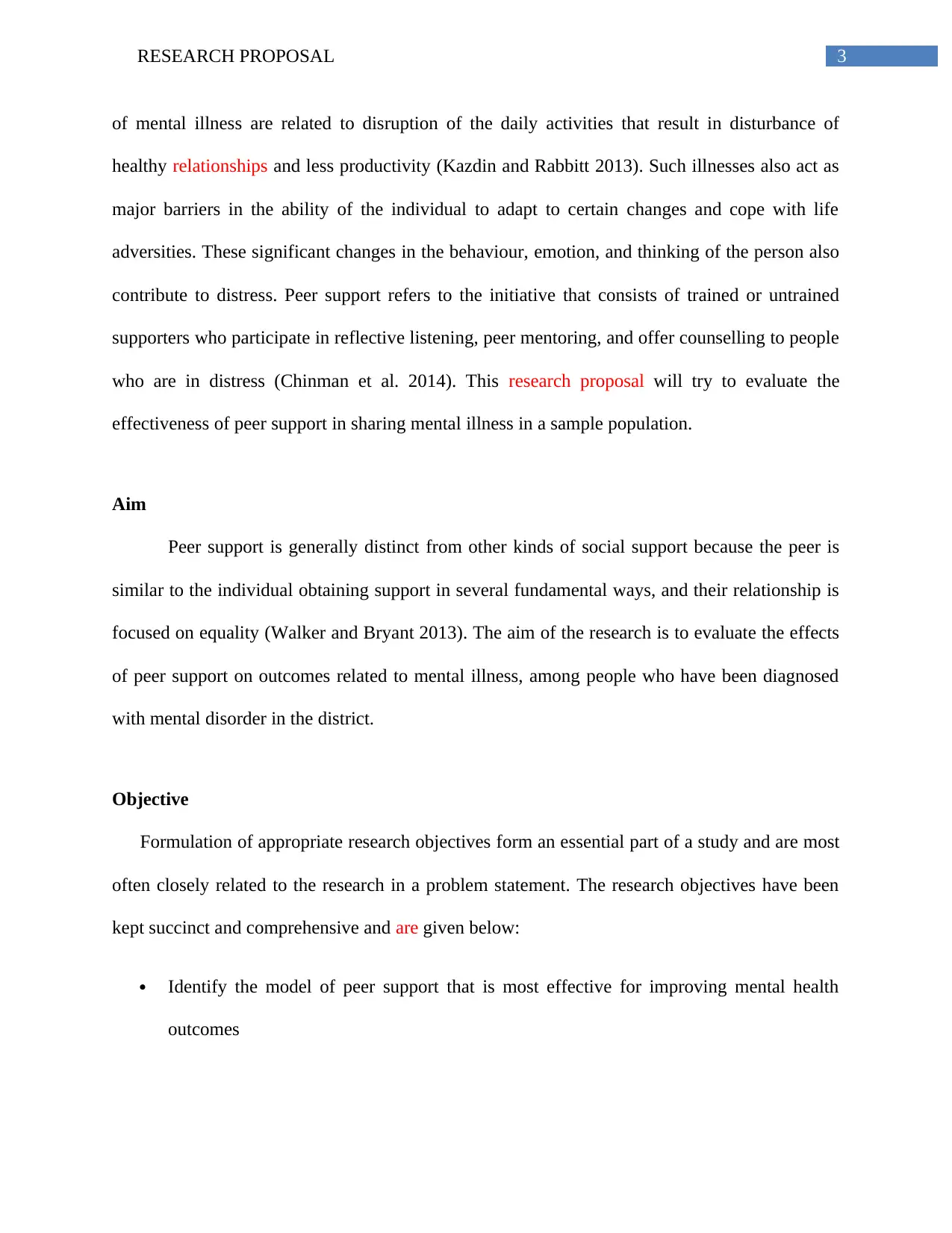
3RESEARCH PROPOSAL
of mental illness are related to disruption of the daily activities that result in disturbance of
healthy relationships and less productivity (Kazdin and Rabbitt 2013). Such illnesses also act as
major barriers in the ability of the individual to adapt to certain changes and cope with life
adversities. These significant changes in the behaviour, emotion, and thinking of the person also
contribute to distress. Peer support refers to the initiative that consists of trained or untrained
supporters who participate in reflective listening, peer mentoring, and offer counselling to people
who are in distress (Chinman et al. 2014). This research proposal will try to evaluate the
effectiveness of peer support in sharing mental illness in a sample population.
Aim
Peer support is generally distinct from other kinds of social support because the peer is
similar to the individual obtaining support in several fundamental ways, and their relationship is
focused on equality (Walker and Bryant 2013). The aim of the research is to evaluate the effects
of peer support on outcomes related to mental illness, among people who have been diagnosed
with mental disorder in the district.
Objective
Formulation of appropriate research objectives form an essential part of a study and are most
often closely related to the research in a problem statement. The research objectives have been
kept succinct and comprehensive and are given below:
Identify the model of peer support that is most effective for improving mental health
outcomes
of mental illness are related to disruption of the daily activities that result in disturbance of
healthy relationships and less productivity (Kazdin and Rabbitt 2013). Such illnesses also act as
major barriers in the ability of the individual to adapt to certain changes and cope with life
adversities. These significant changes in the behaviour, emotion, and thinking of the person also
contribute to distress. Peer support refers to the initiative that consists of trained or untrained
supporters who participate in reflective listening, peer mentoring, and offer counselling to people
who are in distress (Chinman et al. 2014). This research proposal will try to evaluate the
effectiveness of peer support in sharing mental illness in a sample population.
Aim
Peer support is generally distinct from other kinds of social support because the peer is
similar to the individual obtaining support in several fundamental ways, and their relationship is
focused on equality (Walker and Bryant 2013). The aim of the research is to evaluate the effects
of peer support on outcomes related to mental illness, among people who have been diagnosed
with mental disorder in the district.
Objective
Formulation of appropriate research objectives form an essential part of a study and are most
often closely related to the research in a problem statement. The research objectives have been
kept succinct and comprehensive and are given below:
Identify the model of peer support that is most effective for improving mental health
outcomes
Paraphrase This Document
Need a fresh take? Get an instant paraphrase of this document with our AI Paraphraser
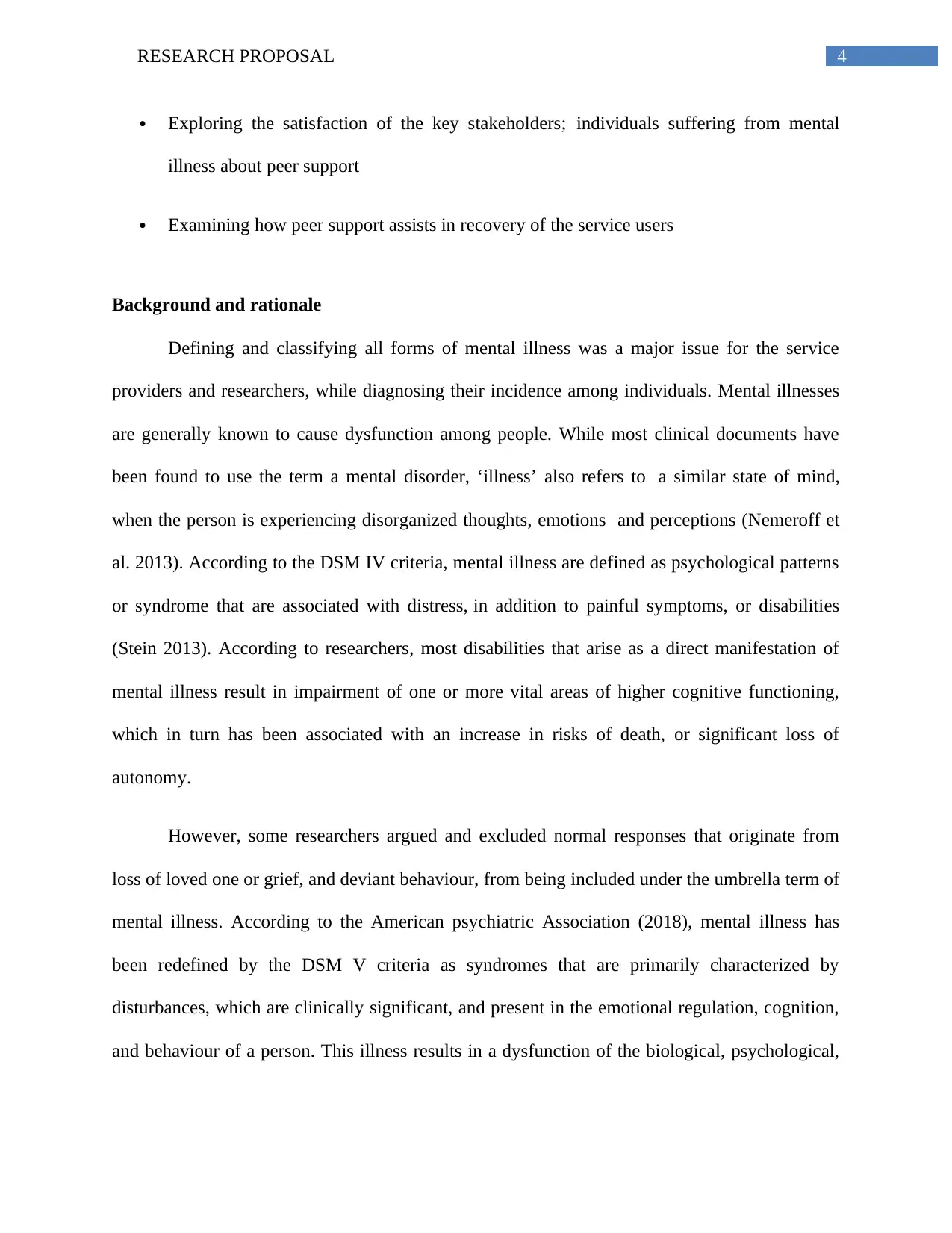
4RESEARCH PROPOSAL
Exploring the satisfaction of the key stakeholders; individuals suffering from mental
illness about peer support
Examining how peer support assists in recovery of the service users
Background and rationale
Defining and classifying all forms of mental illness was a major issue for the service
providers and researchers, while diagnosing their incidence among individuals. Mental illnesses
are generally known to cause dysfunction among people. While most clinical documents have
been found to use the term a mental disorder, ‘illness’ also refers to a similar state of mind,
when the person is experiencing disorganized thoughts, emotions and perceptions (Nemeroff et
al. 2013). According to the DSM IV criteria, mental illness are defined as psychological patterns
or syndrome that are associated with distress, in addition to painful symptoms, or disabilities
(Stein 2013). According to researchers, most disabilities that arise as a direct manifestation of
mental illness result in impairment of one or more vital areas of higher cognitive functioning,
which in turn has been associated with an increase in risks of death, or significant loss of
autonomy.
However, some researchers argued and excluded normal responses that originate from
loss of loved one or grief, and deviant behaviour, from being included under the umbrella term of
mental illness. According to the American psychiatric Association (2018), mental illness has
been redefined by the DSM V criteria as syndromes that are primarily characterized by
disturbances, which are clinically significant, and present in the emotional regulation, cognition,
and behaviour of a person. This illness results in a dysfunction of the biological, psychological,
Exploring the satisfaction of the key stakeholders; individuals suffering from mental
illness about peer support
Examining how peer support assists in recovery of the service users
Background and rationale
Defining and classifying all forms of mental illness was a major issue for the service
providers and researchers, while diagnosing their incidence among individuals. Mental illnesses
are generally known to cause dysfunction among people. While most clinical documents have
been found to use the term a mental disorder, ‘illness’ also refers to a similar state of mind,
when the person is experiencing disorganized thoughts, emotions and perceptions (Nemeroff et
al. 2013). According to the DSM IV criteria, mental illness are defined as psychological patterns
or syndrome that are associated with distress, in addition to painful symptoms, or disabilities
(Stein 2013). According to researchers, most disabilities that arise as a direct manifestation of
mental illness result in impairment of one or more vital areas of higher cognitive functioning,
which in turn has been associated with an increase in risks of death, or significant loss of
autonomy.
However, some researchers argued and excluded normal responses that originate from
loss of loved one or grief, and deviant behaviour, from being included under the umbrella term of
mental illness. According to the American psychiatric Association (2018), mental illness has
been redefined by the DSM V criteria as syndromes that are primarily characterized by
disturbances, which are clinically significant, and present in the emotional regulation, cognition,
and behaviour of a person. This illness results in a dysfunction of the biological, psychological,
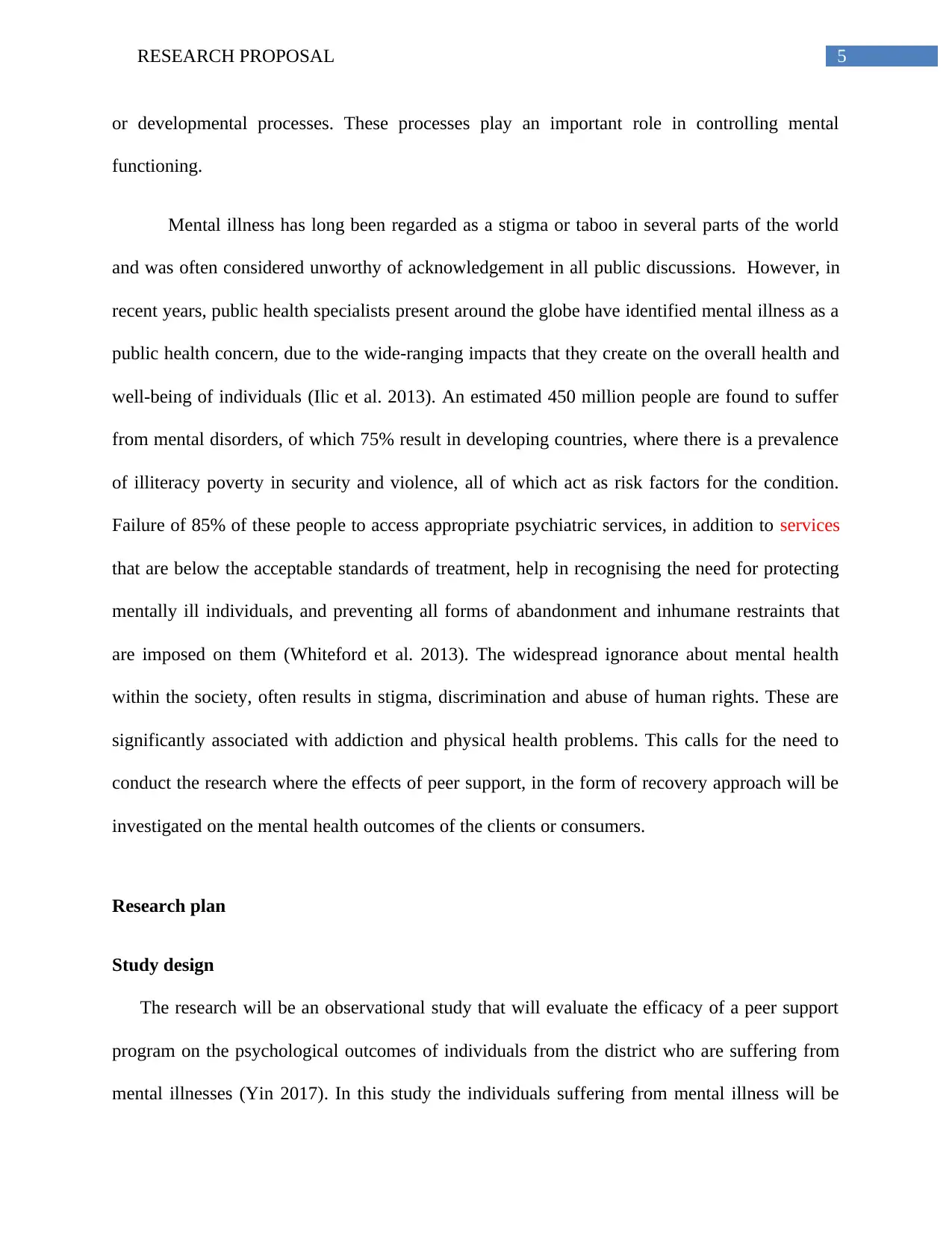
5RESEARCH PROPOSAL
or developmental processes. These processes play an important role in controlling mental
functioning.
Mental illness has long been regarded as a stigma or taboo in several parts of the world
and was often considered unworthy of acknowledgement in all public discussions. However, in
recent years, public health specialists present around the globe have identified mental illness as a
public health concern, due to the wide-ranging impacts that they create on the overall health and
well-being of individuals (Ilic et al. 2013). An estimated 450 million people are found to suffer
from mental disorders, of which 75% result in developing countries, where there is a prevalence
of illiteracy poverty in security and violence, all of which act as risk factors for the condition.
Failure of 85% of these people to access appropriate psychiatric services, in addition to services
that are below the acceptable standards of treatment, help in recognising the need for protecting
mentally ill individuals, and preventing all forms of abandonment and inhumane restraints that
are imposed on them (Whiteford et al. 2013). The widespread ignorance about mental health
within the society, often results in stigma, discrimination and abuse of human rights. These are
significantly associated with addiction and physical health problems. This calls for the need to
conduct the research where the effects of peer support, in the form of recovery approach will be
investigated on the mental health outcomes of the clients or consumers.
Research plan
Study design
The research will be an observational study that will evaluate the efficacy of a peer support
program on the psychological outcomes of individuals from the district who are suffering from
mental illnesses (Yin 2017). In this study the individuals suffering from mental illness will be
or developmental processes. These processes play an important role in controlling mental
functioning.
Mental illness has long been regarded as a stigma or taboo in several parts of the world
and was often considered unworthy of acknowledgement in all public discussions. However, in
recent years, public health specialists present around the globe have identified mental illness as a
public health concern, due to the wide-ranging impacts that they create on the overall health and
well-being of individuals (Ilic et al. 2013). An estimated 450 million people are found to suffer
from mental disorders, of which 75% result in developing countries, where there is a prevalence
of illiteracy poverty in security and violence, all of which act as risk factors for the condition.
Failure of 85% of these people to access appropriate psychiatric services, in addition to services
that are below the acceptable standards of treatment, help in recognising the need for protecting
mentally ill individuals, and preventing all forms of abandonment and inhumane restraints that
are imposed on them (Whiteford et al. 2013). The widespread ignorance about mental health
within the society, often results in stigma, discrimination and abuse of human rights. These are
significantly associated with addiction and physical health problems. This calls for the need to
conduct the research where the effects of peer support, in the form of recovery approach will be
investigated on the mental health outcomes of the clients or consumers.
Research plan
Study design
The research will be an observational study that will evaluate the efficacy of a peer support
program on the psychological outcomes of individuals from the district who are suffering from
mental illnesses (Yin 2017). In this study the individuals suffering from mental illness will be
⊘ This is a preview!⊘
Do you want full access?
Subscribe today to unlock all pages.

Trusted by 1+ million students worldwide
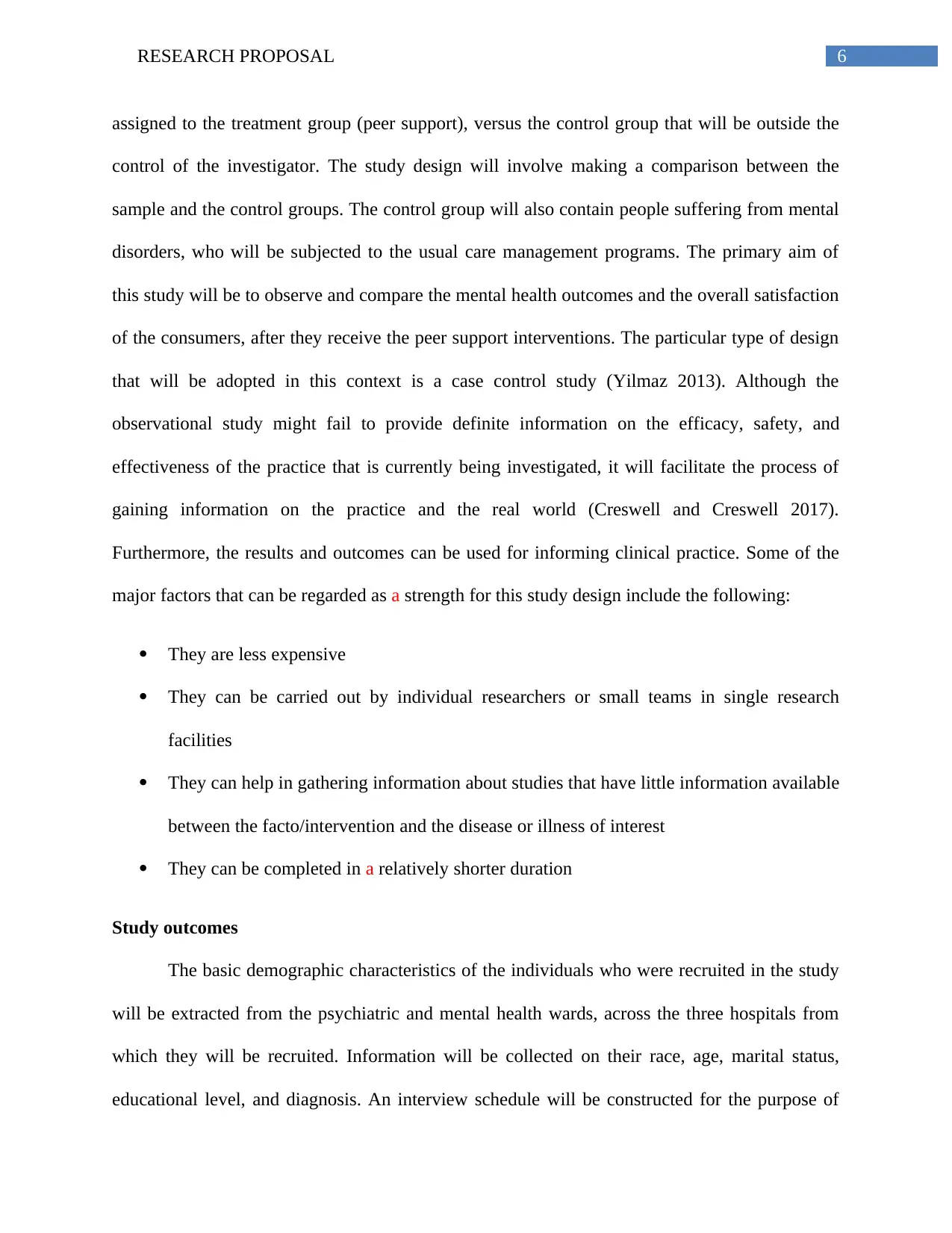
6RESEARCH PROPOSAL
assigned to the treatment group (peer support), versus the control group that will be outside the
control of the investigator. The study design will involve making a comparison between the
sample and the control groups. The control group will also contain people suffering from mental
disorders, who will be subjected to the usual care management programs. The primary aim of
this study will be to observe and compare the mental health outcomes and the overall satisfaction
of the consumers, after they receive the peer support interventions. The particular type of design
that will be adopted in this context is a case control study (Yilmaz 2013). Although the
observational study might fail to provide definite information on the efficacy, safety, and
effectiveness of the practice that is currently being investigated, it will facilitate the process of
gaining information on the practice and the real world (Creswell and Creswell 2017).
Furthermore, the results and outcomes can be used for informing clinical practice. Some of the
major factors that can be regarded as a strength for this study design include the following:
They are less expensive
They can be carried out by individual researchers or small teams in single research
facilities
They can help in gathering information about studies that have little information available
between the facto/intervention and the disease or illness of interest
They can be completed in a relatively shorter duration
Study outcomes
The basic demographic characteristics of the individuals who were recruited in the study
will be extracted from the psychiatric and mental health wards, across the three hospitals from
which they will be recruited. Information will be collected on their race, age, marital status,
educational level, and diagnosis. An interview schedule will be constructed for the purpose of
assigned to the treatment group (peer support), versus the control group that will be outside the
control of the investigator. The study design will involve making a comparison between the
sample and the control groups. The control group will also contain people suffering from mental
disorders, who will be subjected to the usual care management programs. The primary aim of
this study will be to observe and compare the mental health outcomes and the overall satisfaction
of the consumers, after they receive the peer support interventions. The particular type of design
that will be adopted in this context is a case control study (Yilmaz 2013). Although the
observational study might fail to provide definite information on the efficacy, safety, and
effectiveness of the practice that is currently being investigated, it will facilitate the process of
gaining information on the practice and the real world (Creswell and Creswell 2017).
Furthermore, the results and outcomes can be used for informing clinical practice. Some of the
major factors that can be regarded as a strength for this study design include the following:
They are less expensive
They can be carried out by individual researchers or small teams in single research
facilities
They can help in gathering information about studies that have little information available
between the facto/intervention and the disease or illness of interest
They can be completed in a relatively shorter duration
Study outcomes
The basic demographic characteristics of the individuals who were recruited in the study
will be extracted from the psychiatric and mental health wards, across the three hospitals from
which they will be recruited. Information will be collected on their race, age, marital status,
educational level, and diagnosis. An interview schedule will be constructed for the purpose of
Paraphrase This Document
Need a fresh take? Get an instant paraphrase of this document with our AI Paraphraser
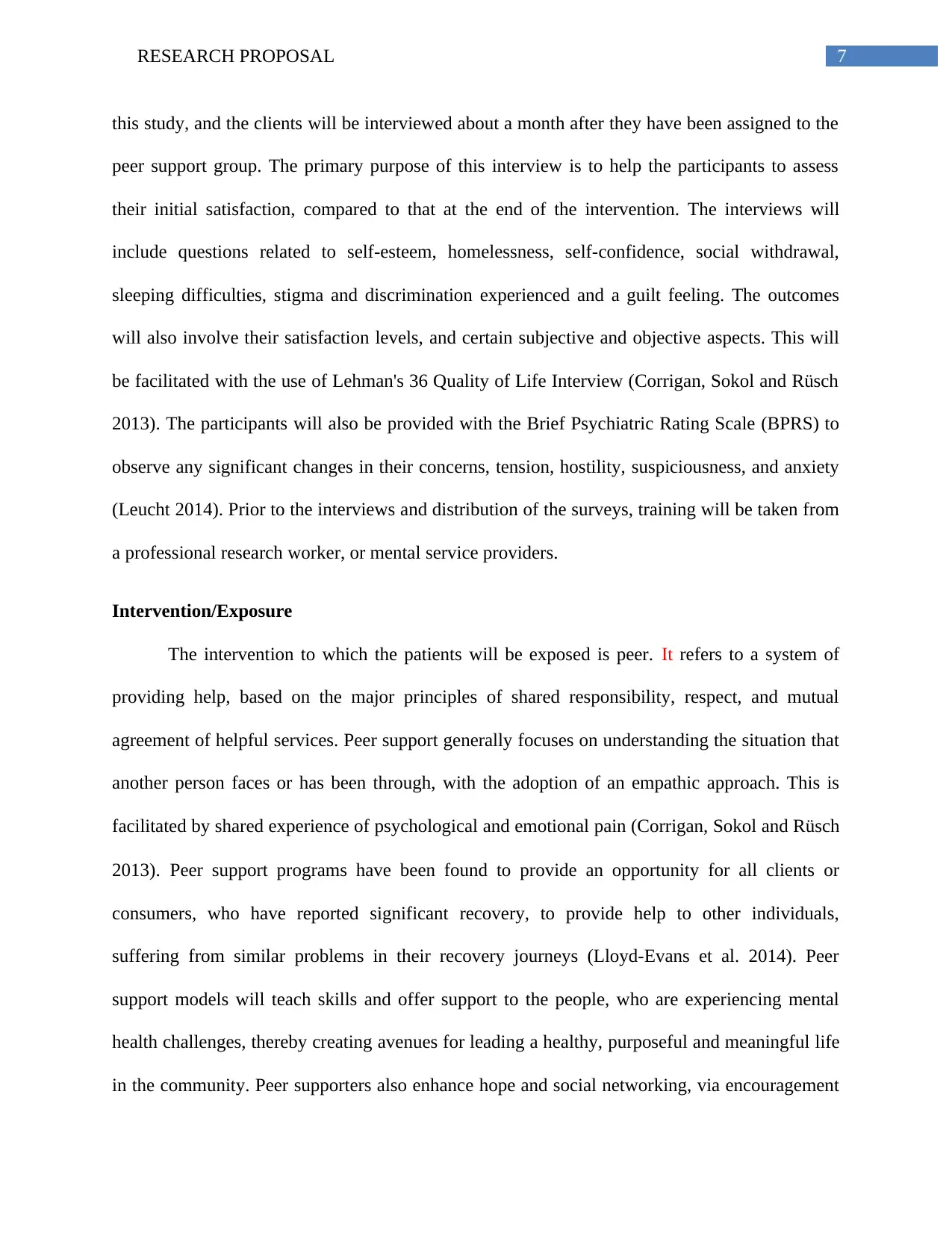
7RESEARCH PROPOSAL
this study, and the clients will be interviewed about a month after they have been assigned to the
peer support group. The primary purpose of this interview is to help the participants to assess
their initial satisfaction, compared to that at the end of the intervention. The interviews will
include questions related to self-esteem, homelessness, self-confidence, social withdrawal,
sleeping difficulties, stigma and discrimination experienced and a guilt feeling. The outcomes
will also involve their satisfaction levels, and certain subjective and objective aspects. This will
be facilitated with the use of Lehman's 36 Quality of Life Interview (Corrigan, Sokol and Rüsch
2013). The participants will also be provided with the Brief Psychiatric Rating Scale (BPRS) to
observe any significant changes in their concerns, tension, hostility, suspiciousness, and anxiety
(Leucht 2014). Prior to the interviews and distribution of the surveys, training will be taken from
a professional research worker, or mental service providers.
Intervention/Exposure
The intervention to which the patients will be exposed is peer. It refers to a system of
providing help, based on the major principles of shared responsibility, respect, and mutual
agreement of helpful services. Peer support generally focuses on understanding the situation that
another person faces or has been through, with the adoption of an empathic approach. This is
facilitated by shared experience of psychological and emotional pain (Corrigan, Sokol and Rüsch
2013). Peer support programs have been found to provide an opportunity for all clients or
consumers, who have reported significant recovery, to provide help to other individuals,
suffering from similar problems in their recovery journeys (Lloyd-Evans et al. 2014). Peer
support models will teach skills and offer support to the people, who are experiencing mental
health challenges, thereby creating avenues for leading a healthy, purposeful and meaningful life
in the community. Peer supporters also enhance hope and social networking, via encouragement
this study, and the clients will be interviewed about a month after they have been assigned to the
peer support group. The primary purpose of this interview is to help the participants to assess
their initial satisfaction, compared to that at the end of the intervention. The interviews will
include questions related to self-esteem, homelessness, self-confidence, social withdrawal,
sleeping difficulties, stigma and discrimination experienced and a guilt feeling. The outcomes
will also involve their satisfaction levels, and certain subjective and objective aspects. This will
be facilitated with the use of Lehman's 36 Quality of Life Interview (Corrigan, Sokol and Rüsch
2013). The participants will also be provided with the Brief Psychiatric Rating Scale (BPRS) to
observe any significant changes in their concerns, tension, hostility, suspiciousness, and anxiety
(Leucht 2014). Prior to the interviews and distribution of the surveys, training will be taken from
a professional research worker, or mental service providers.
Intervention/Exposure
The intervention to which the patients will be exposed is peer. It refers to a system of
providing help, based on the major principles of shared responsibility, respect, and mutual
agreement of helpful services. Peer support generally focuses on understanding the situation that
another person faces or has been through, with the adoption of an empathic approach. This is
facilitated by shared experience of psychological and emotional pain (Corrigan, Sokol and Rüsch
2013). Peer support programs have been found to provide an opportunity for all clients or
consumers, who have reported significant recovery, to provide help to other individuals,
suffering from similar problems in their recovery journeys (Lloyd-Evans et al. 2014). Peer
support models will teach skills and offer support to the people, who are experiencing mental
health challenges, thereby creating avenues for leading a healthy, purposeful and meaningful life
in the community. Peer supporters also enhance hope and social networking, via encouragement
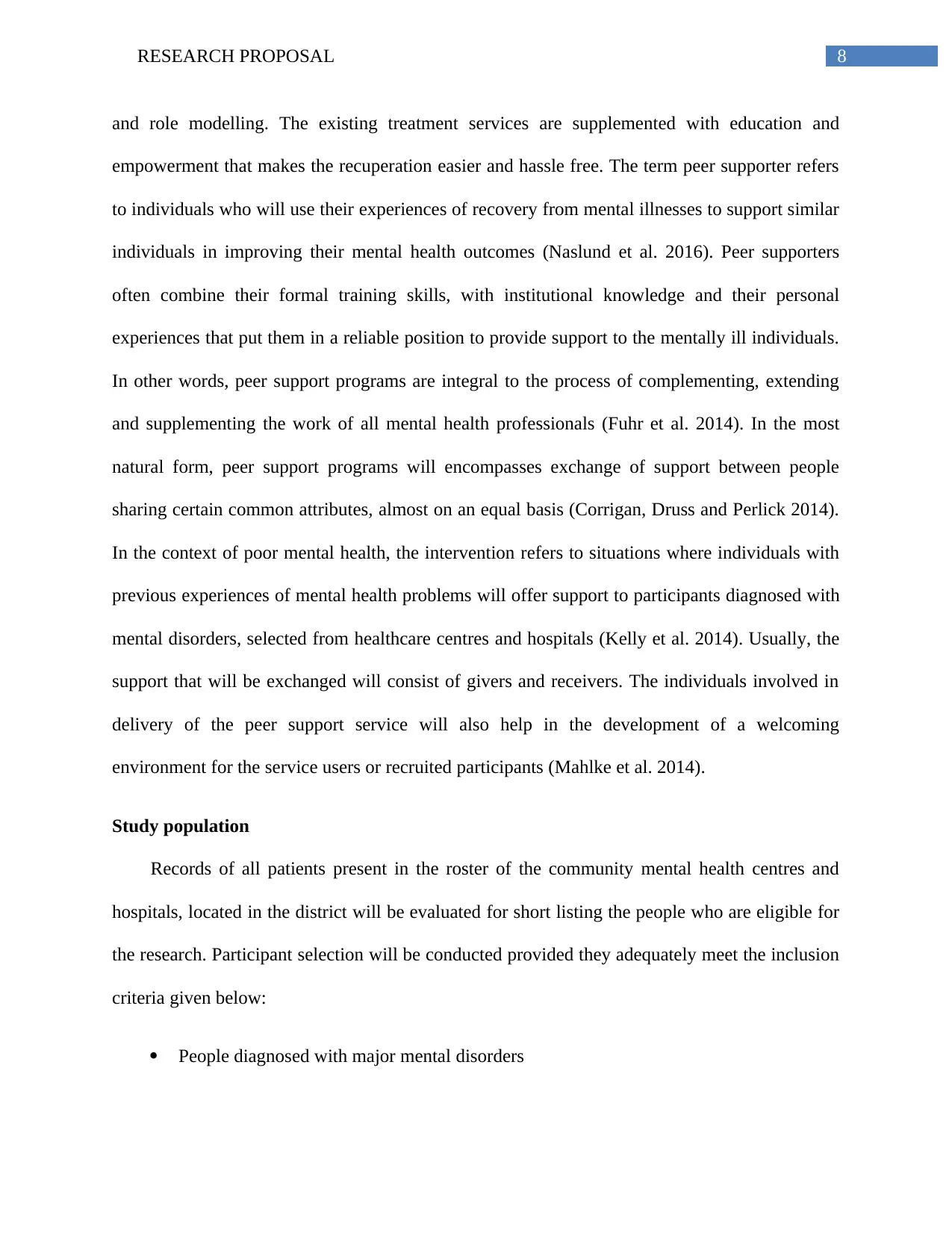
8RESEARCH PROPOSAL
and role modelling. The existing treatment services are supplemented with education and
empowerment that makes the recuperation easier and hassle free. The term peer supporter refers
to individuals who will use their experiences of recovery from mental illnesses to support similar
individuals in improving their mental health outcomes (Naslund et al. 2016). Peer supporters
often combine their formal training skills, with institutional knowledge and their personal
experiences that put them in a reliable position to provide support to the mentally ill individuals.
In other words, peer support programs are integral to the process of complementing, extending
and supplementing the work of all mental health professionals (Fuhr et al. 2014). In the most
natural form, peer support programs will encompasses exchange of support between people
sharing certain common attributes, almost on an equal basis (Corrigan, Druss and Perlick 2014).
In the context of poor mental health, the intervention refers to situations where individuals with
previous experiences of mental health problems will offer support to participants diagnosed with
mental disorders, selected from healthcare centres and hospitals (Kelly et al. 2014). Usually, the
support that will be exchanged will consist of givers and receivers. The individuals involved in
delivery of the peer support service will also help in the development of a welcoming
environment for the service users or recruited participants (Mahlke et al. 2014).
Study population
Records of all patients present in the roster of the community mental health centres and
hospitals, located in the district will be evaluated for short listing the people who are eligible for
the research. Participant selection will be conducted provided they adequately meet the inclusion
criteria given below:
People diagnosed with major mental disorders
and role modelling. The existing treatment services are supplemented with education and
empowerment that makes the recuperation easier and hassle free. The term peer supporter refers
to individuals who will use their experiences of recovery from mental illnesses to support similar
individuals in improving their mental health outcomes (Naslund et al. 2016). Peer supporters
often combine their formal training skills, with institutional knowledge and their personal
experiences that put them in a reliable position to provide support to the mentally ill individuals.
In other words, peer support programs are integral to the process of complementing, extending
and supplementing the work of all mental health professionals (Fuhr et al. 2014). In the most
natural form, peer support programs will encompasses exchange of support between people
sharing certain common attributes, almost on an equal basis (Corrigan, Druss and Perlick 2014).
In the context of poor mental health, the intervention refers to situations where individuals with
previous experiences of mental health problems will offer support to participants diagnosed with
mental disorders, selected from healthcare centres and hospitals (Kelly et al. 2014). Usually, the
support that will be exchanged will consist of givers and receivers. The individuals involved in
delivery of the peer support service will also help in the development of a welcoming
environment for the service users or recruited participants (Mahlke et al. 2014).
Study population
Records of all patients present in the roster of the community mental health centres and
hospitals, located in the district will be evaluated for short listing the people who are eligible for
the research. Participant selection will be conducted provided they adequately meet the inclusion
criteria given below:
People diagnosed with major mental disorders
⊘ This is a preview!⊘
Do you want full access?
Subscribe today to unlock all pages.

Trusted by 1+ million students worldwide
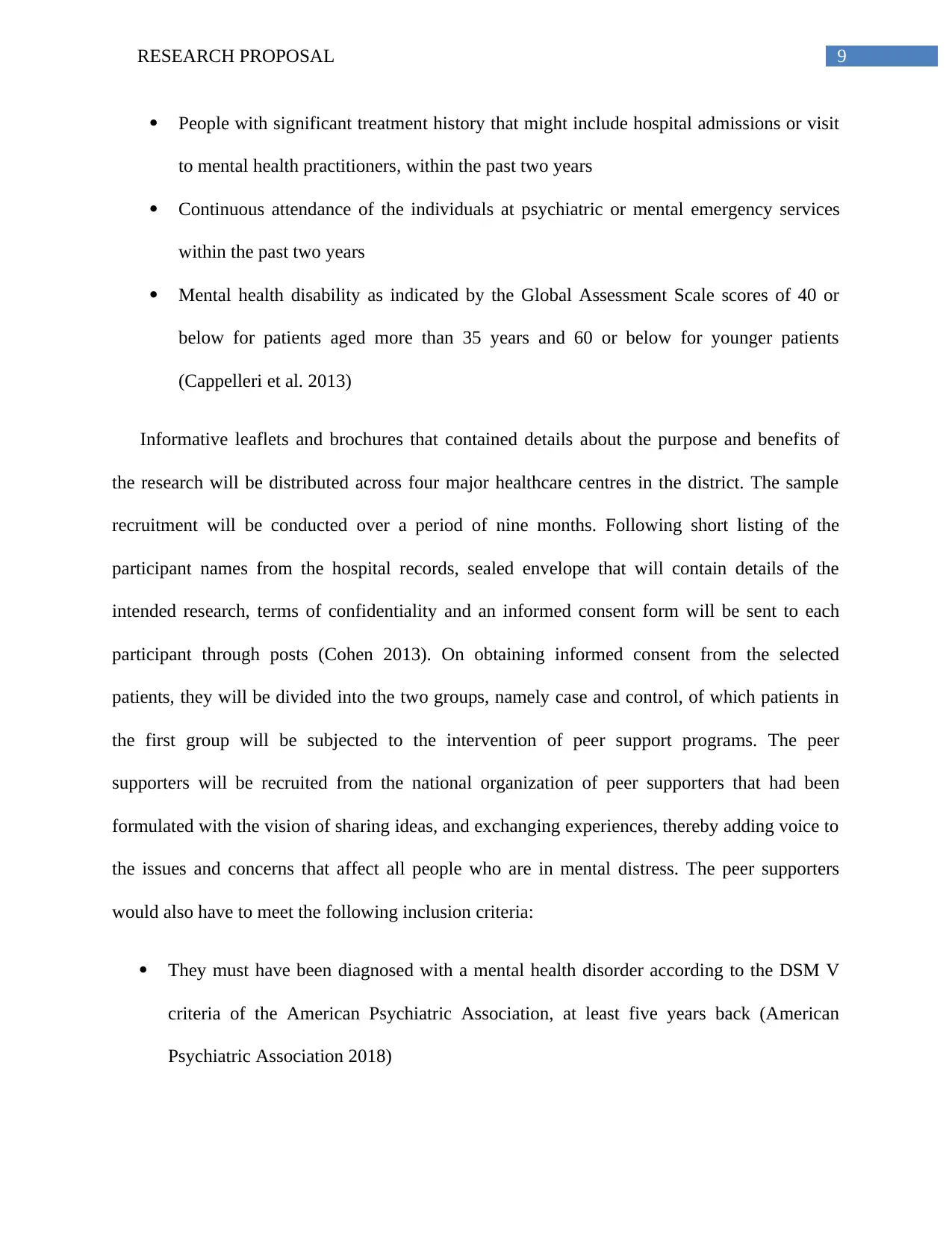
9RESEARCH PROPOSAL
People with significant treatment history that might include hospital admissions or visit
to mental health practitioners, within the past two years
Continuous attendance of the individuals at psychiatric or mental emergency services
within the past two years
Mental health disability as indicated by the Global Assessment Scale scores of 40 or
below for patients aged more than 35 years and 60 or below for younger patients
(Cappelleri et al. 2013)
Informative leaflets and brochures that contained details about the purpose and benefits of
the research will be distributed across four major healthcare centres in the district. The sample
recruitment will be conducted over a period of nine months. Following short listing of the
participant names from the hospital records, sealed envelope that will contain details of the
intended research, terms of confidentiality and an informed consent form will be sent to each
participant through posts (Cohen 2013). On obtaining informed consent from the selected
patients, they will be divided into the two groups, namely case and control, of which patients in
the first group will be subjected to the intervention of peer support programs. The peer
supporters will be recruited from the national organization of peer supporters that had been
formulated with the vision of sharing ideas, and exchanging experiences, thereby adding voice to
the issues and concerns that affect all people who are in mental distress. The peer supporters
would also have to meet the following inclusion criteria:
They must have been diagnosed with a mental health disorder according to the DSM V
criteria of the American Psychiatric Association, at least five years back (American
Psychiatric Association 2018)
People with significant treatment history that might include hospital admissions or visit
to mental health practitioners, within the past two years
Continuous attendance of the individuals at psychiatric or mental emergency services
within the past two years
Mental health disability as indicated by the Global Assessment Scale scores of 40 or
below for patients aged more than 35 years and 60 or below for younger patients
(Cappelleri et al. 2013)
Informative leaflets and brochures that contained details about the purpose and benefits of
the research will be distributed across four major healthcare centres in the district. The sample
recruitment will be conducted over a period of nine months. Following short listing of the
participant names from the hospital records, sealed envelope that will contain details of the
intended research, terms of confidentiality and an informed consent form will be sent to each
participant through posts (Cohen 2013). On obtaining informed consent from the selected
patients, they will be divided into the two groups, namely case and control, of which patients in
the first group will be subjected to the intervention of peer support programs. The peer
supporters will be recruited from the national organization of peer supporters that had been
formulated with the vision of sharing ideas, and exchanging experiences, thereby adding voice to
the issues and concerns that affect all people who are in mental distress. The peer supporters
would also have to meet the following inclusion criteria:
They must have been diagnosed with a mental health disorder according to the DSM V
criteria of the American Psychiatric Association, at least five years back (American
Psychiatric Association 2018)
Paraphrase This Document
Need a fresh take? Get an instant paraphrase of this document with our AI Paraphraser
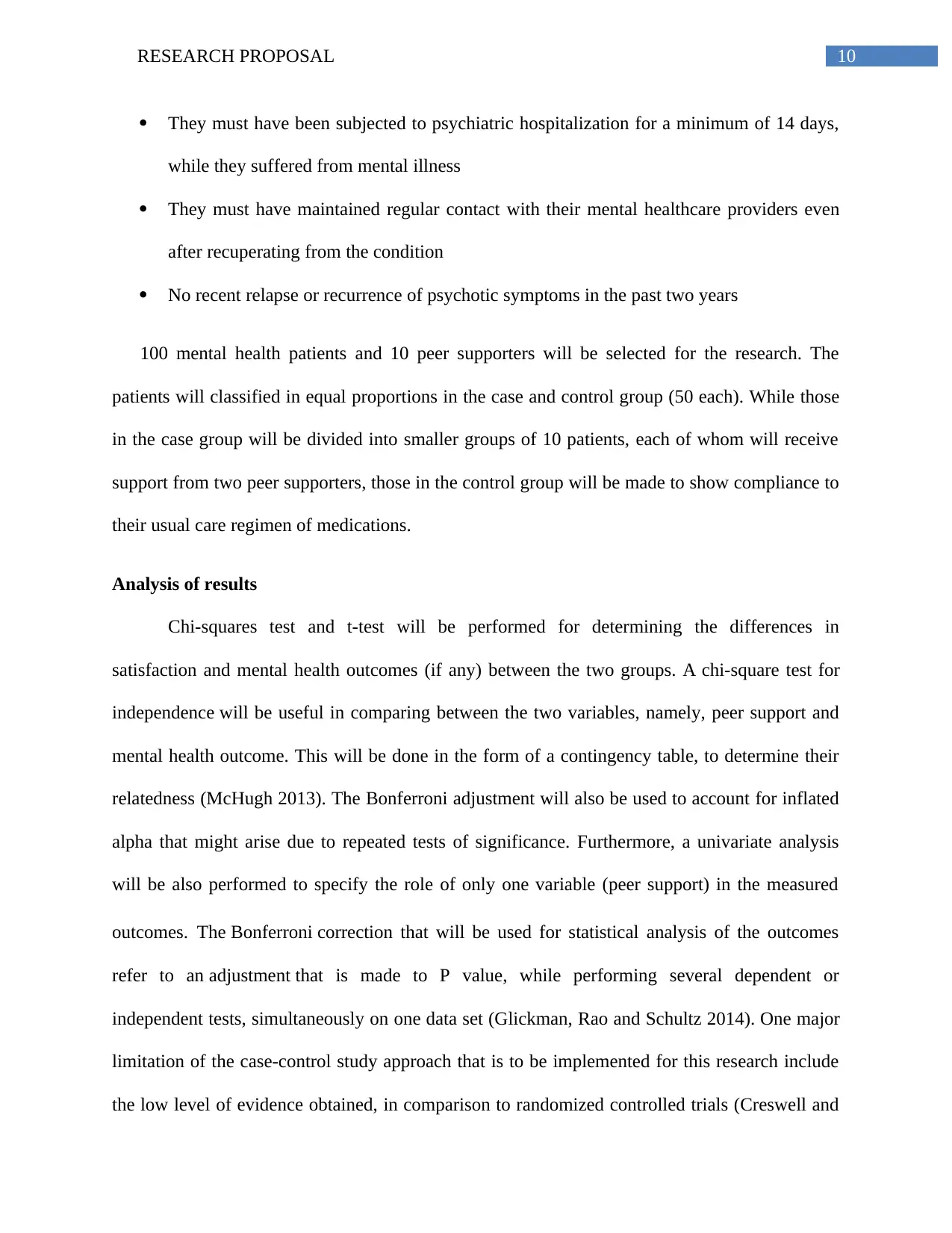
10RESEARCH PROPOSAL
They must have been subjected to psychiatric hospitalization for a minimum of 14 days,
while they suffered from mental illness
They must have maintained regular contact with their mental healthcare providers even
after recuperating from the condition
No recent relapse or recurrence of psychotic symptoms in the past two years
100 mental health patients and 10 peer supporters will be selected for the research. The
patients will classified in equal proportions in the case and control group (50 each). While those
in the case group will be divided into smaller groups of 10 patients, each of whom will receive
support from two peer supporters, those in the control group will be made to show compliance to
their usual care regimen of medications.
Analysis of results
Chi-squares test and t-test will be performed for determining the differences in
satisfaction and mental health outcomes (if any) between the two groups. A chi-square test for
independence will be useful in comparing between the two variables, namely, peer support and
mental health outcome. This will be done in the form of a contingency table, to determine their
relatedness (McHugh 2013). The Bonferroni adjustment will also be used to account for inflated
alpha that might arise due to repeated tests of significance. Furthermore, a univariate analysis
will be also performed to specify the role of only one variable (peer support) in the measured
outcomes. The Bonferroni correction that will be used for statistical analysis of the outcomes
refer to an adjustment that is made to P value, while performing several dependent or
independent tests, simultaneously on one data set (Glickman, Rao and Schultz 2014). One major
limitation of the case-control study approach that is to be implemented for this research include
the low level of evidence obtained, in comparison to randomized controlled trials (Creswell and
They must have been subjected to psychiatric hospitalization for a minimum of 14 days,
while they suffered from mental illness
They must have maintained regular contact with their mental healthcare providers even
after recuperating from the condition
No recent relapse or recurrence of psychotic symptoms in the past two years
100 mental health patients and 10 peer supporters will be selected for the research. The
patients will classified in equal proportions in the case and control group (50 each). While those
in the case group will be divided into smaller groups of 10 patients, each of whom will receive
support from two peer supporters, those in the control group will be made to show compliance to
their usual care regimen of medications.
Analysis of results
Chi-squares test and t-test will be performed for determining the differences in
satisfaction and mental health outcomes (if any) between the two groups. A chi-square test for
independence will be useful in comparing between the two variables, namely, peer support and
mental health outcome. This will be done in the form of a contingency table, to determine their
relatedness (McHugh 2013). The Bonferroni adjustment will also be used to account for inflated
alpha that might arise due to repeated tests of significance. Furthermore, a univariate analysis
will be also performed to specify the role of only one variable (peer support) in the measured
outcomes. The Bonferroni correction that will be used for statistical analysis of the outcomes
refer to an adjustment that is made to P value, while performing several dependent or
independent tests, simultaneously on one data set (Glickman, Rao and Schultz 2014). One major
limitation of the case-control study approach that is to be implemented for this research include
the low level of evidence obtained, in comparison to randomized controlled trials (Creswell and
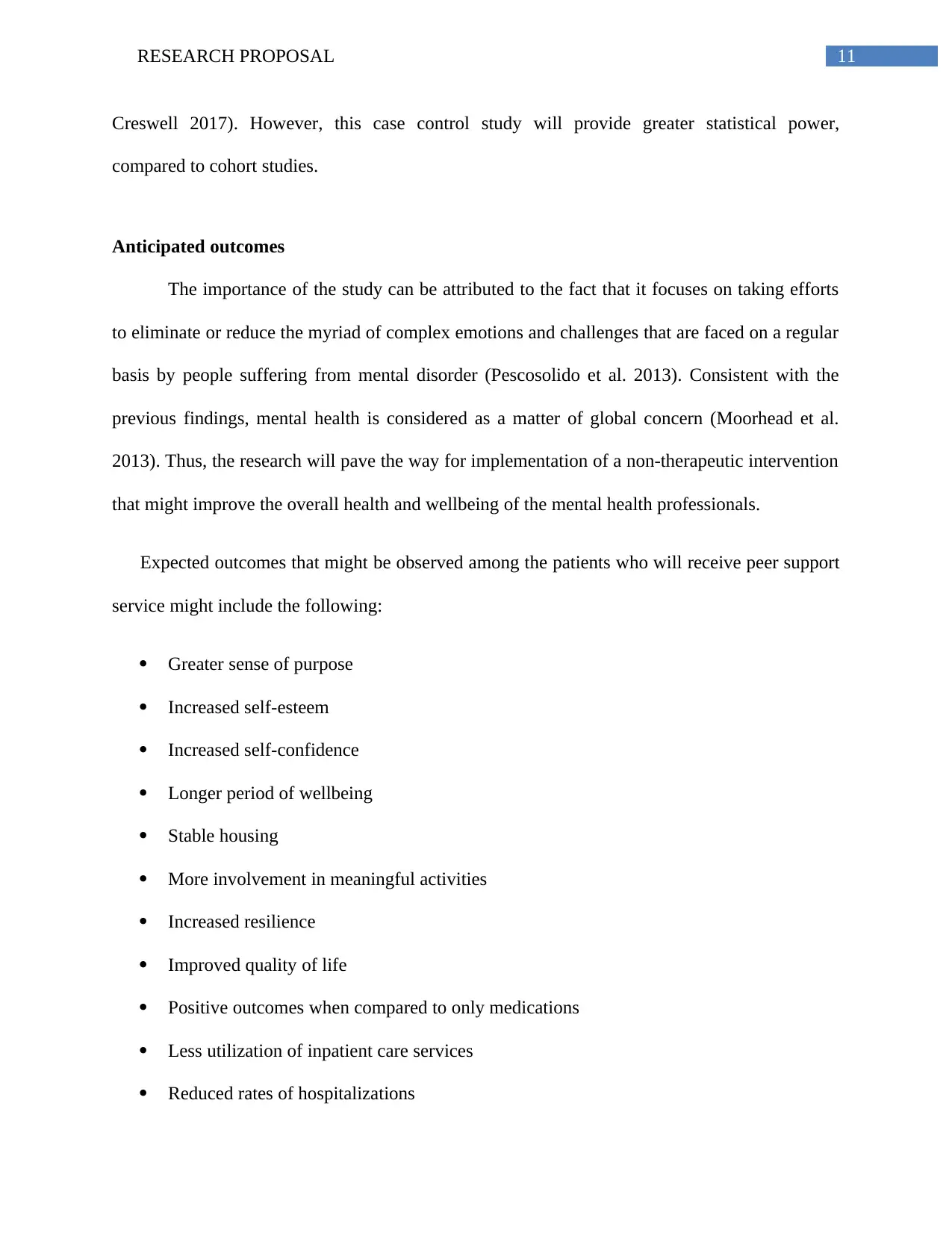
11RESEARCH PROPOSAL
Creswell 2017). However, this case control study will provide greater statistical power,
compared to cohort studies.
Anticipated outcomes
The importance of the study can be attributed to the fact that it focuses on taking efforts
to eliminate or reduce the myriad of complex emotions and challenges that are faced on a regular
basis by people suffering from mental disorder (Pescosolido et al. 2013). Consistent with the
previous findings, mental health is considered as a matter of global concern (Moorhead et al.
2013). Thus, the research will pave the way for implementation of a non-therapeutic intervention
that might improve the overall health and wellbeing of the mental health professionals.
Expected outcomes that might be observed among the patients who will receive peer support
service might include the following:
Greater sense of purpose
Increased self-esteem
Increased self-confidence
Longer period of wellbeing
Stable housing
More involvement in meaningful activities
Increased resilience
Improved quality of life
Positive outcomes when compared to only medications
Less utilization of inpatient care services
Reduced rates of hospitalizations
Creswell 2017). However, this case control study will provide greater statistical power,
compared to cohort studies.
Anticipated outcomes
The importance of the study can be attributed to the fact that it focuses on taking efforts
to eliminate or reduce the myriad of complex emotions and challenges that are faced on a regular
basis by people suffering from mental disorder (Pescosolido et al. 2013). Consistent with the
previous findings, mental health is considered as a matter of global concern (Moorhead et al.
2013). Thus, the research will pave the way for implementation of a non-therapeutic intervention
that might improve the overall health and wellbeing of the mental health professionals.
Expected outcomes that might be observed among the patients who will receive peer support
service might include the following:
Greater sense of purpose
Increased self-esteem
Increased self-confidence
Longer period of wellbeing
Stable housing
More involvement in meaningful activities
Increased resilience
Improved quality of life
Positive outcomes when compared to only medications
Less utilization of inpatient care services
Reduced rates of hospitalizations
⊘ This is a preview!⊘
Do you want full access?
Subscribe today to unlock all pages.

Trusted by 1+ million students worldwide
1 out of 19
Related Documents
Your All-in-One AI-Powered Toolkit for Academic Success.
+13062052269
info@desklib.com
Available 24*7 on WhatsApp / Email
![[object Object]](/_next/static/media/star-bottom.7253800d.svg)
Unlock your academic potential
Copyright © 2020–2025 A2Z Services. All Rights Reserved. Developed and managed by ZUCOL.





